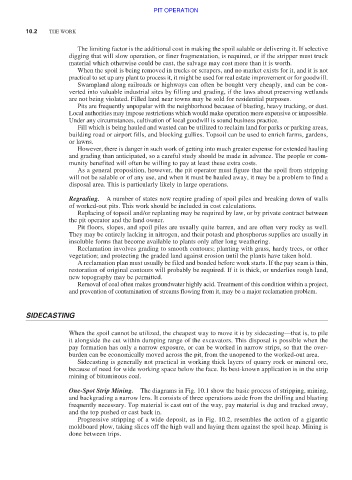Page 496 - Moving the Earth_ The Workbook of Excavation
P. 496
PIT OPERATION
10.2 THE WORK
The limiting factor is the additional cost in making the spoil salable or delivering it. If selective
digging that will slow operation, or finer fragmentation, is required, or if the stripper must truck
material which otherwise could be cast, the salvage may cost more than it is worth.
When the spoil is being removed in trucks or scrapers, and no market exists for it, and it is not
practical to set up any plant to process it, it might be used for real estate improvement or for goodwill.
Swampland along railroads or highways can often be bought very cheaply, and can be con-
verted into valuable industrial sites by filling and grading, if the laws about preserving wetlands
are not being violated. Filled land near towns may be sold for residential purposes.
Pits are frequently unpopular with the neighborhood because of blasting, heavy trucking, or dust.
Local authorities may impose restrictions which would make operation more expensive or impossible.
Under any circumstances, cultivation of local goodwill is sound business practice.
Fill which is being hauled and wasted can be utilized to reclaim land for parks or parking areas,
building road or airport fills, and blocking gullies. Topsoil can be used to enrich farms, gardens,
or lawns.
However, there is danger in such work of getting into much greater expense for extended hauling
and grading than anticipated, so a careful study should be made in advance. The people or com-
munity benefited will often be willing to pay at least these extra costs.
As a general proposition, however, the pit operator must figure that the spoil from stripping
will not be salable or of any use, and when it must be hauled away, it may be a problem to find a
disposal area. This is particularly likely in large operations.
Regrading. A number of states now require grading of spoil piles and breaking down of walls
of worked-out pits. This work should be included in cost calculations.
Replacing of topsoil and/or replanting may be required by law, or by private contract between
the pit operator and the land owner.
Pit floors, slopes, and spoil piles are usually quite barren, and are often very rocky as well.
They may be entirely lacking in nitrogen, and their potash and phosphorus supplies are usually in
insoluble forms that become available to plants only after long weathering.
Reclamation involves grading to smooth contours; planting with grass, hardy trees, or other
vegetation; and protecting the graded land against erosion until the plants have taken hold.
A reclamation plan must usually be filed and bonded before work starts. If the pay seam is thin,
restoration of original contours will probably be required. If it is thick, or underlies rough land,
new topography may be permitted.
Removal of coal often makes groundwater highly acid. Treatment of this condition within a project,
and prevention of contamination of streams flowing from it, may be a major reclamation problem.
SIDECASTING
When the spoil cannot be utilized, the cheapest way to move it is by sidecasting—that is, to pile
it alongside the cut within dumping range of the excavators. This disposal is possible when the
pay formation has only a narrow exposure, or can be worked in narrow strips, so that the over-
burden can be economically moved across the pit, from the unopened to the worked-out area.
Sidecasting is generally not practical in working thick layers of quarry rock or mineral ore,
because of need for wide working space below the face. Its best-known application is in the strip
mining of bituminous coal.
One-Spot Strip Mining. The diagrams in Fig. 10.1 show the basic process of stripping, mining,
and backgrading a narrow lens. It consists of three operations aside from the drilling and blasting
frequently necessary. Top material is cast out of the way, pay material is dug and trucked away,
and the top pushed or cast back in.
Progressive stripping of a wide deposit, as in Fig. 10.2, resembles the action of a gigantic
moldboard plow, taking slices off the high wall and laying them against the spoil heap. Mining is
done between trips.

